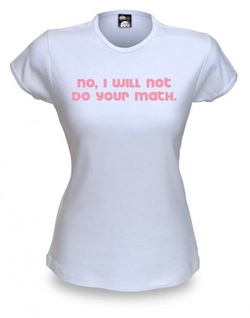Harvard has a series of Implicit Association Tests for anyone to try online. One of these tests is there to determine how you associate gender and science. To start, you are asked what your opinion is on those topics. Are men better at it, or do women equal them in every aspect? The test then has you categorize “male” and “female” terms alongside “science” and “liberal arts” terms. Based on the speed of your reaction, the test can tell you whether or not your subconscious makes gender associations with science.
Your humble blogger is ashamed to admit that she failed the test.
At least, in my own mind I did. According to the test, I have “moderate associations with men and science,” as well as women with liberal arts. Granted, they weren’t “strong” associations, but I would have preferred to come out as neutral as I consciously claim to be.
Many things could have affected this outcome: I come from a family of entertainers, and have clearly chosen a liberal arts path for myself. None of my female friends are particularly scientifically or mathematically minded. Most of my male friends were much better at math and science than I was in school. Then again, the genders of my math and science teachers over the years were relatively split down the middle. I was never discouraged from enjoying those subjects (though I did have some rotten teachers in high school). So why the subconscious betrayal?
Well how are they selling it to us, ladies?
They’ve been cropping up all over the internet lately—a sea of sexist clothing and toys intended for girls. The first crisis came up over a shirt that JC Penny had for sale, decked out with the charming text, “I’m too pretty to do homework so my brother has to do it for me.” Then there was the “Allergic to Algebra” shirt. ThinkGeek has been kind enough to make the wearable rebuttal, but the damage has been done, and there are undoubtedly some little girls walking around wearing those demeaning adverts proudly. How could they know better?
 Then Wild! Science came out with kits for kids that were color-coded—say it with me—pink for girls and blue for boys. But it didn’t stop there: the girls were encouraged to use science kits that allowed them to make perfume and bath bombs, the boys were encouraged to launch rockets, make slime, and do chemistry.
Then Wild! Science came out with kits for kids that were color-coded—say it with me—pink for girls and blue for boys. But it didn’t stop there: the girls were encouraged to use science kits that allowed them to make perfume and bath bombs, the boys were encouraged to launch rockets, make slime, and do chemistry.
Now, some girls will ignore those labels and go for the kits that interest them most; I launched toy rockets with my dad as a kid. But some girls won’t. And more importantly, the fact that the pink kits feature only little girls on the boxes with adjectives like “beautiful” and “mystic” preceding them ensures that most boys won’t touch them. Even if making a crystal lagoon sounds like fun.
I’m not the first person to make this argument, but the problem goes so far beyond girls doing science and math. On the subway not long ago, I saw a mother with her two children. Her daughter was wearing plastic jewelry and her son was jealous: he wanted to wear some of it. His mother was clearly irritated, but instead of telling them that he couldn’t just have things that belonged to his sister, or asking her daughter to share, her comment was “No, you can’t have that. Those aren’t for boys.”
Nevermind the fact that I’ve met quite a few men who wear jewelry.
 The Dangerous Books for Boys was a huge hit a few years back, and The Daring Book for Girls was quick to follow. But the while the girls book did contain useful information on how to change tires and start fires, I’m pretty sure that the boys book didn’t carry lessons for palm-reading or having a séance. Why? I read boys’ palms when I was a kid. They got a kick out of it. Guess that’s a “daring” activity, but not “dangerous” enough for them. The Dangerous Book for Boys, on the other hand, had lessons for building a treehouse.
The Dangerous Books for Boys was a huge hit a few years back, and The Daring Book for Girls was quick to follow. But the while the girls book did contain useful information on how to change tires and start fires, I’m pretty sure that the boys book didn’t carry lessons for palm-reading or having a séance. Why? I read boys’ palms when I was a kid. They got a kick out of it. Guess that’s a “daring” activity, but not “dangerous” enough for them. The Dangerous Book for Boys, on the other hand, had lessons for building a treehouse.
You know what? I would have loved to build a treehouse. Why is there a different book for me? Couldn’t this be one mega book—The Daring and Dangerous Book for Kids?
It’s not just science. It’s not just math. It’s not just about girls being “too pretty” to do homework. (What does that even mean?) It’s about gender-coding every color, toy and activity that children do, to the point where disobeying those rules can lead to terrible consequences among their peers.
Or to put it another way, it’s about teaching our girls to sit still and be calm, and teaching our boys to beat each other with plastic weapons. As pointed out very succinctly in this essay, the toys we give to girls often teach them to be passive, to sit and socialize and do repetitive tasks. The toys we give to boys are hands on, they are active, often teaching aggression and competitiveness. Girls bake muffins, boys play war games.
Girls have séances. Boys build treehouses.
Does that affect how many women will eventually become scientists and mathematicians? It certainly isn’t the only defining factor, but you can bet it has a lot to do with it. After all, building a birdhouse could lead to a life in engineering. Playing with a toy rocket could lead to astronomy and astrophysics. There’s nothing wrong with becoming a baker or a fashion designer, but don’t you want every girl to be given all the options? Don’t you owe them that?
Though I’m upset at how my Implicit Associations Test turned out, I can honestly say that I was given those options. I had a pink tutu and a fairy wand and a tea set. I also had a plastic saber and cowboy six-shooters and a rock collection. I was never told that something was “for boys” and I couldn’t play with it or attempt it. And if that hadn’t been true, I would not be here writing this today. So we need to keep fighting, and call these things out when we see them.
Someone’s daughter is the next Cecilia Payne. She just needs the right science kit.
Emmet Asher-Perrin had an Aladdin playset before the Jasmine playset. The Aladdin one was way cooler—it had a sword, a compass, and a magic lamp. You can bug her on Twitter and read more of her work here and elsewhere.










